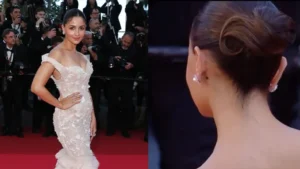Calling makeup “just vanity” is about as outdated as saying women can’t lead. From ancient queens to modern rebels, makeup has rarely been about only looking good. It’s been armour, protest, seduction, defiance, and even political war paint. Behind every stroke of eyeliner and swipe of blush lies a complex, often radical, history that deserves far more respect than it gets. So, if you’ve ever been told to stop painting your face and “embrace your natural beauty,” sit tight because the history of makeup has a little something to say about that.
Related: Put Your Makeup To Work: 6 Ways To Use Your Red Lipstick That Are Simply Genius
Kohl was never about the eyes
The origins of eyeliner date back to ancient Egypt, where both men and women wore kohl to define their eyes, not for seduction, but for strength. Lining your eyes was as much about spiritual protection as it was aesthetic. Kohl was believed to ward off evil spirits and shield the eyes from the sun’s harsh glare. Cleopatra’s iconic winged liner? It wasn’t just for the drama; it was a statement of divine power and sacred femininity.

Even in India, kohl or kajal isn’t just to enhance beauty; it is also used to protect ourselves from buri nazar. We have witnessed celebrities like Alia Bhatt and Janhvi Kapoor with a kaala teeka multiple times. The history of makeup might not be known much but it reiterates why applying makeup isn’t something to be ashamed of.
Lipstick is a stick of rebellion

Red lipstick has long been a weapon of bold defiance. Queen Elizabeth I rocked a dramatic red lip as part of her stark white painted face. But even then, makeup was controversial. And not everyone approved. Red lips were often seen as wild, and even evil. Religious leaders called it sinful. Society said it was only for ‘bad women’.
By the 20th century, red lipstick had started shifting from taboo to trend, thanks, in no small part, to Hollywood. Actors like Clara Bow and later Marilyn Monroe turned it into a screen siren signature. During World War II, red lipstick became an actual weapon of morale. While men went to the frontlines, women took over the workforce. American cosmetic brands launched patriotic shades like Elizabeth Arden’s “Victory Red”, specifically created for female military personnel. Even Hitler reportedly hated red lipstick, which only made Allied women wear it more. When everything from chocolate to silk was rationed, the production of lipstick was actively encouraged. Winston Churchill famously insisted that lipstick shouldn’t be banned, calling it essential for morale.
In Indian cinema, red lips were used to mark a woman as bold or bad. Vamps or seductresses wore red lipstick to show they were dangerous or seductive. The ‘good girls’ stuck to lighter shades. In Khoon Bhari Maang, when Rekha’s character decides to avenge herself, you can see the shift from her plain look to bold red lips. For the longest time, the easiest way to show that a woman can’t be controlled was to paint her lips red.
The moral corruption of blush
Blush is having a moment with trends like #blushblindness, but not long ago, wearing it meant you were morally questionable. In the Victorian era, a natural flush was fine, but to be caught applying blush was scandalous. Why? Because painted cheeks were associated with prostitutes and “fallen women.” Respectable ladies were meant to have naturally blushing cheeks; anything artificial was considered morally questionable. Women would pinch their cheeks or bite their lips for colour, but heaven forbid they be seen with a rouge pot.
But that’s not it. In 18th-century France, both men and women wore heavy blush as a symbol of standing against the norms prevailing in those times. Blush was a symbol of rebellion. However, post-Revolution, rouge became symbolic of the excess and vanity of the elite. If you had the time to apply rouge, that simply meant you had servants taking care of other tasks.
Foundation has always been a class issue

Skin tone and complexion have historically been markers of class. In ancient Greece and Rome, pale skin was prized; it meant you were wealthy enough to avoid outdoor labour. Women would use lead-based foundations (with, of course, disastrous health effects) to achieve this look. The paler the face, the higher the status.
However, the 20th century flipped this on its head. A tan became desirable — a sign you could afford holidays and leisure time. And just like that, makeup marketing followed suit, pushing bronzers, fake tans, and contouring kits. Even in India, the reign of Fair & Lovely was more than a trend; it was an ideology, and the protest against it was a sign of rebellion against the norms of beauty. Fair & Lovely didn’t become Glow & Lovely, because “to glow” was the trend; it happened because people decided to shatter the framework of beauty being translated to fair.
So, yes, makeup isn’t just vanity. The history of makeup tells us that it has been a tool for rebellion, a way to mark identity, and perhaps most powerfully, a means of reclaiming autonomy in a world that constantly polices femininity.
Featured Image Source
Related: Why Are Women In Beed, Maharashtra, Losing Their Wombs To Cut Sugarcane?

 Web Stories
Web Stories













